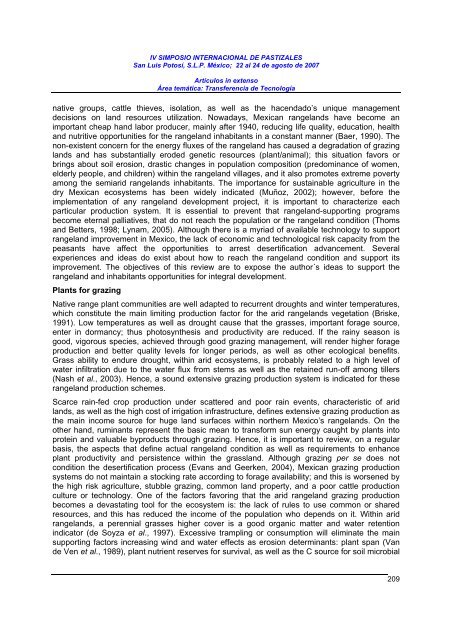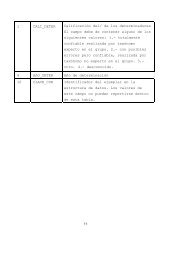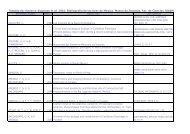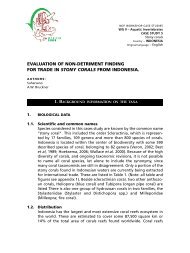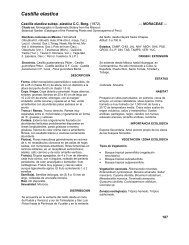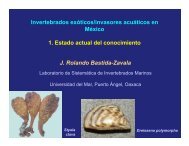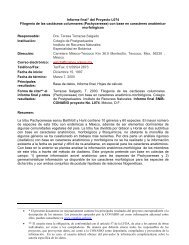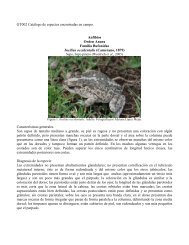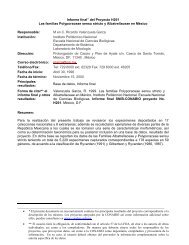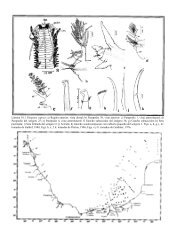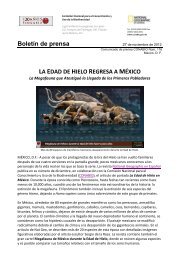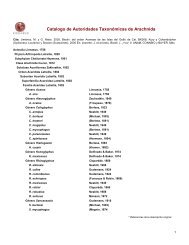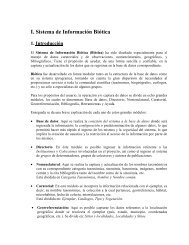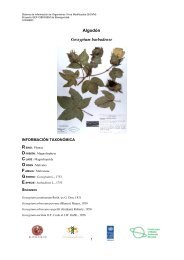ecosystem services to and from north american arid ... - Conabio
ecosystem services to and from north american arid ... - Conabio
ecosystem services to and from north american arid ... - Conabio
Create successful ePaper yourself
Turn your PDF publications into a flip-book with our unique Google optimized e-Paper software.
IV SIMPOSIO INTERNACIONAL DE PASTIZALES<br />
San Luis Po<strong>to</strong>sí, S.L.P. México; 22 al 24 de agos<strong>to</strong> de 2007<br />
Artículos in extenso<br />
Área temática: Transferencia de Tecnología<br />
native groups, cattle thieves, isolation, as well as the hacendado’s unique management<br />
decisions on l<strong>and</strong> resources utilization. Nowadays, Mexican rangel<strong>and</strong>s have become an<br />
important cheap h<strong>and</strong> labor producer, mainly after 1940, reducing life quality, education, health<br />
<strong>and</strong> nutritive opportunities for the rangel<strong>and</strong> inhabitants in a constant manner (Baer, 1990). The<br />
non-existent concern for the energy fluxes of the rangel<strong>and</strong> has caused a degradation of grazing<br />
l<strong>and</strong>s <strong>and</strong> has substantially eroded genetic resources (plant/animal); this situation favors or<br />
brings about soil erosion, drastic changes in population composition (predominance of women,<br />
elderly people, <strong>and</strong> children) within the rangel<strong>and</strong> villages, <strong>and</strong> it also promotes extreme poverty<br />
among the semi<strong>arid</strong> rangel<strong>and</strong>s inhabitants. The importance for sustainable agriculture in the<br />
dry Mexican <strong>ecosystem</strong>s has been widely indicated (Muñoz, 2002); however, before the<br />
implementation of any rangel<strong>and</strong> development project, it is important <strong>to</strong> characterize each<br />
particular production system. It is essential <strong>to</strong> prevent that rangel<strong>and</strong>-supporting programs<br />
become eternal palliatives, that do not reach the population or the rangel<strong>and</strong> condition (Thoms<br />
<strong>and</strong> Betters, 1998; Lynam, 2005). Although there is a myriad of available technology <strong>to</strong> support<br />
rangel<strong>and</strong> improvement in Mexico, the lack of economic <strong>and</strong> technological risk capacity <strong>from</strong> the<br />
peasants have affect the opportunities <strong>to</strong> arrest desertification advancement. Several<br />
experiences <strong>and</strong> ideas do exist about how <strong>to</strong> reach the rangel<strong>and</strong> condition <strong>and</strong> support its<br />
improvement. The objectives of this review are <strong>to</strong> expose the author´s ideas <strong>to</strong> support the<br />
rangel<strong>and</strong> <strong>and</strong> inhabitants opportunities for integral development.<br />
Plants for grazing<br />
Native range plant communities are well adapted <strong>to</strong> recurrent droughts <strong>and</strong> winter temperatures,<br />
which constitute the main limiting production fac<strong>to</strong>r for the <strong>arid</strong> rangel<strong>and</strong>s vegetation (Briske,<br />
1991). Low temperatures as well as drought cause that the grasses, important forage source,<br />
enter in dormancy; thus pho<strong>to</strong>synthesis <strong>and</strong> productivity are reduced. If the rainy season is<br />
good, vigorous species, achieved through good grazing management, will render higher forage<br />
production <strong>and</strong> better quality levels for longer periods, as well as other ecological benefits.<br />
Grass ability <strong>to</strong> endure drought, within <strong>arid</strong> <strong>ecosystem</strong>s, is probably related <strong>to</strong> a high level of<br />
water infiltration due <strong>to</strong> the water flux <strong>from</strong> stems as well as the retained run-off among tillers<br />
(Nash et al., 2003). Hence, a sound extensive grazing production system is indicated for these<br />
rangel<strong>and</strong> production schemes.<br />
Scarce rain-fed crop production under scattered <strong>and</strong> poor rain events, characteristic of <strong>arid</strong><br />
l<strong>and</strong>s, as well as the high cost of irrigation infrastructure, defines extensive grazing production as<br />
the main income source for huge l<strong>and</strong> surfaces within <strong>north</strong>ern Mexico’s rangel<strong>and</strong>s. On the<br />
other h<strong>and</strong>, ruminants represent the basic mean <strong>to</strong> transform sun energy caught by plants in<strong>to</strong><br />
protein <strong>and</strong> valuable byproducts through grazing. Hence, it is important <strong>to</strong> review, on a regular<br />
basis, the aspects that define actual rangel<strong>and</strong> condition as well as requirements <strong>to</strong> enhance<br />
plant productivity <strong>and</strong> persistence within the grassl<strong>and</strong>. Although grazing per se does not<br />
condition the desertification process (Evans <strong>and</strong> Geerken, 2004), Mexican grazing production<br />
systems do not maintain a s<strong>to</strong>cking rate according <strong>to</strong> forage availability; <strong>and</strong> this is worsened by<br />
the high risk agriculture, stubble grazing, common l<strong>and</strong> property, <strong>and</strong> a poor cattle production<br />
culture or technology. One of the fac<strong>to</strong>rs favoring that the <strong>arid</strong> rangel<strong>and</strong> grazing production<br />
becomes a devastating <strong>to</strong>ol for the <strong>ecosystem</strong> is: the lack of rules <strong>to</strong> use common or shared<br />
resources, <strong>and</strong> this has reduced the income of the population who depends on it. Within <strong>arid</strong><br />
rangel<strong>and</strong>s, a perennial grasses higher cover is a good organic matter <strong>and</strong> water retention<br />
indica<strong>to</strong>r (de Soyza et al., 1997). Excessive trampling or consumption will eliminate the main<br />
supporting fac<strong>to</strong>rs increasing wind <strong>and</strong> water effects as erosion determinants: plant span (Van<br />
de Ven et al., 1989), plant nutrient reserves for survival, as well as the C source for soil microbial<br />
209


